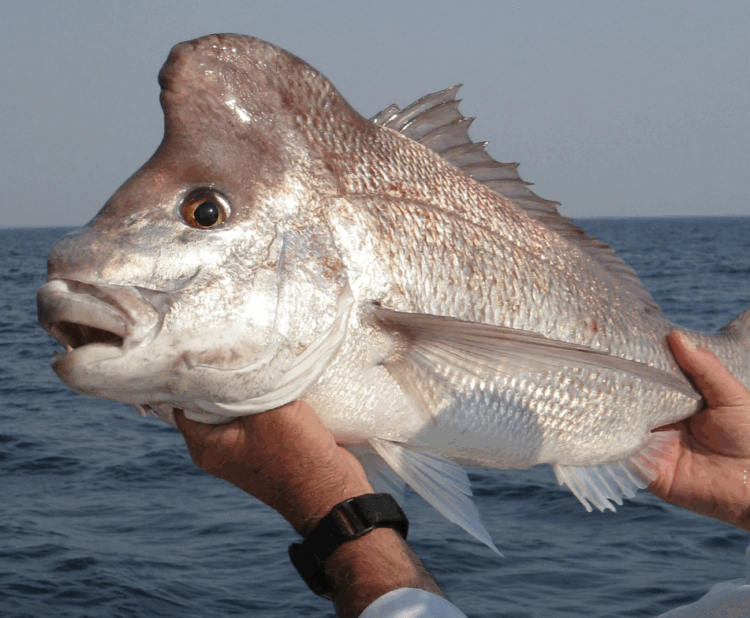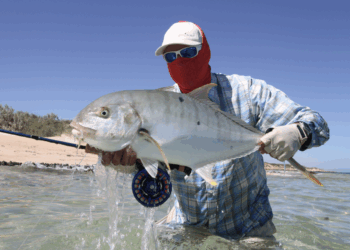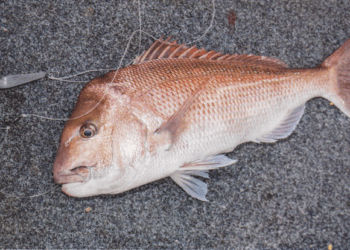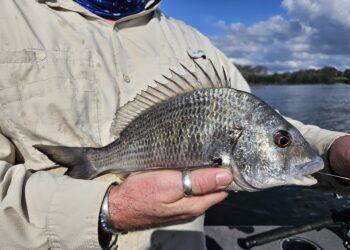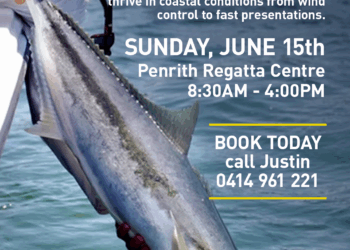TARGETING big snapper with jigs and plastics works well, but as John explains, the trusted technique of using fresh baits is hard to beat.
These days, many of the young-gun fishos target snapper with hard body jigs and soft plastics and they do exceptionally well at it. Many of us oldies though still like to use natural baits and for those anglers who like to do the same thing there are a few tips here you might find handy.
I love catching snapper and over many decades fishing around my home town grounds off Jibbon and Stanwell Park and up north off Coffs Harbour, I’ve caught thousands of them. Along the way I’ve learnt the best terrain to find snapper and the best baits to use to catch them. The type of tackle and special rigs I found the most effective only came after a lot of experimenting.
I found the best way to fool a big snapper into taking a bait is presenting it on a lightly weighted, fine line floated along in the current looking as natural as the burley cubes. I found the best tackle to achieve this floating bait method is using a good old Alvey reel. The control and feel of the line is right there in your fingers and you can even tell if the small pickers are at your bait or something bigger.
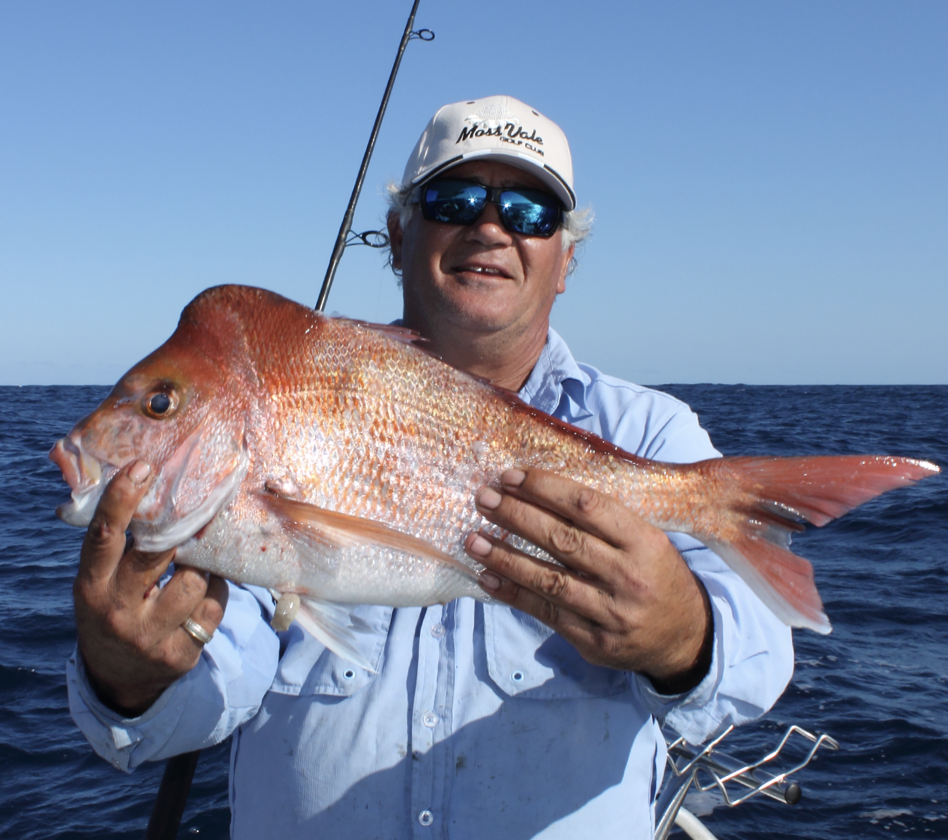
The other technique I found extremely helpful is using a slightly longer than normal boat rod about 2.8metres (9-foot) in length. This length rod not only gives me a lot of fun playing any good size snapper, but it is so useful for casting out unweighted baits when there is no current, or very little. An unweighted bait rigged to just float down through the water columns can be cast out a good 50 metres or so off a longer rod with a fine tip. This has helped me catch a lot of big knobby headed snapper.
BAITS
The best baits to tempt a big red need to be a good size like a whole, plump Western Australian pilchard or the full filleted side off a fresh slimy mackerel or yellowtail. A good long strip of salted striped tuna or the whole body and head of a small squid are also good. Strips from the back of a cuttlefish’s body or the legs and candles are also excellent baits. A small whole octopus like the one in the photo here are also a top bait.
BERLEY
Chopped up WA pilchards or any fresh fish like yellowtail, slimy mackerel and even sweep will make excellent cubes for the burley and the trick is not to over-do it. Just a steady trail like one cube at a time every minute or so. The other ingredients that makes a great berley are dry chicken pellets, purchased in bulk from a produce store. A trickle of these gradually break up as they sink down in the depths and the snapper absolutely love them. At times a hooked snapper will come up to the waiting net spewing up what looks like wet pollen from these broken-down pellets. They’re a cheap and a very effective berley.
HOOKS AND RIGS
Many years ago, I tried using three ganged-up 4/0 hooks for the long strip-baits and often missed a few good snapper bites. That particular ganged up rig is quite stiff, so I made up a rig that was flexible with the use of a swivel between two hooks. The hooks of choice are the good old Mustad 540s and I use a 3/0 for the top hook and a 4/0 for the second, bottom hook. Wow, my hook up rate went up dramatically.
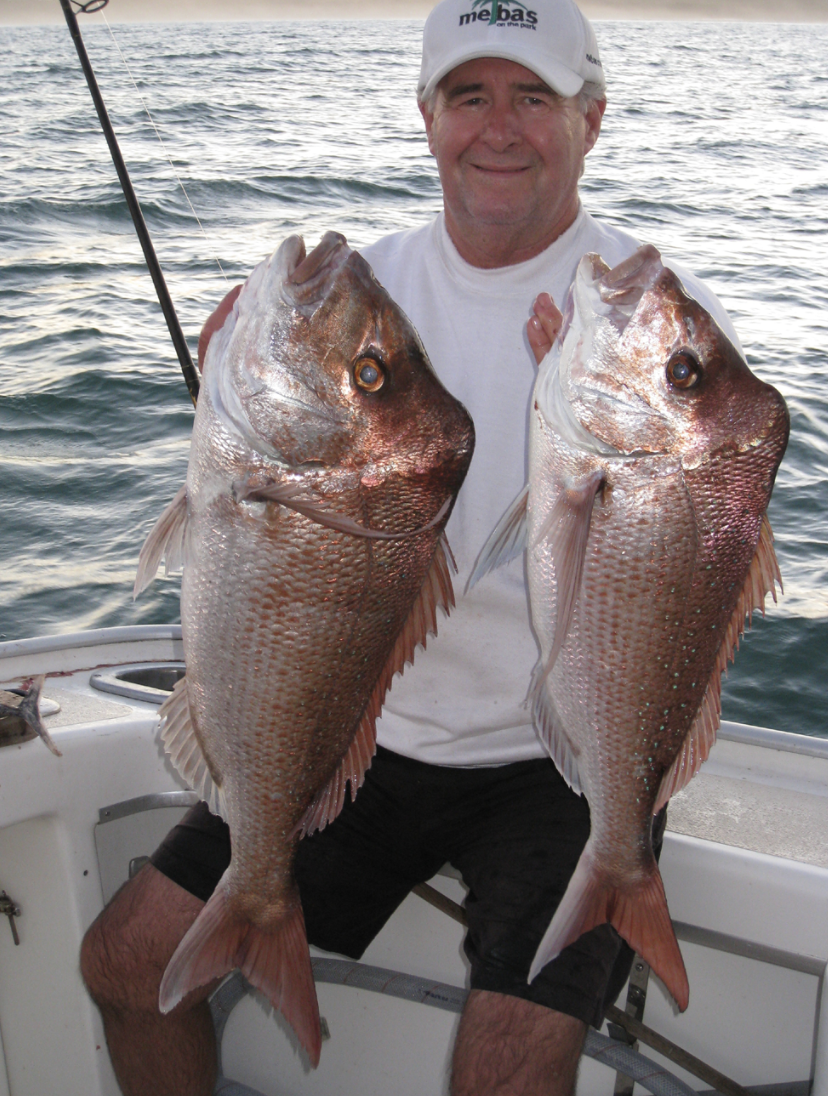
This rig is very easy to make up and the 3/0 hook goes through one end of the brass swivel and sometimes I need to adjust the swivel hole with a pair of side cutters so the hook is a nice snug fit and won’t come back out. Opening the eye of the 4/0 hook with a pair of side cutters allows the other end of the swivel to be attached to the second hook. Closing the eye of the 4/0 hook back up is best done with a pair of flat-jaw pliers. Sharpening both hooks to razer sharp points is also very important.
ANCHORING UP
Chasing snapper, I always anchor up on or near the edge of the reef and when the anchor sets in it will give you an idea of the strength of the current moving past the boat. Throwing a little berley in the water will also give you a good indication of what size sinker is needed to get the bait drifting down and out with the berley. If I need any weight I always use a ball sinker running directly on the line between the hooks and a small swivel tied about sixty centimetres back from the hooks.
SINKERS
The strength of the current naturally determines the size of the ball sinker that’s needed. If there is no current I don’t use a lead weight at all and if there is only a trickle of current I might use a tiny pea-size sinker. If the current is moving along swiftly it might take a few drifts back with the bait and different weight sinkers to get it right. At times the surface current can be running hard, but once the bait gets down a little there might not be too much current at all? Suddenly you find the bait has plummeted to the bottom. When this happens, it can be a juggle as to how much weight is needed and how much line to feed out to stop the bait from going right to the bottom.
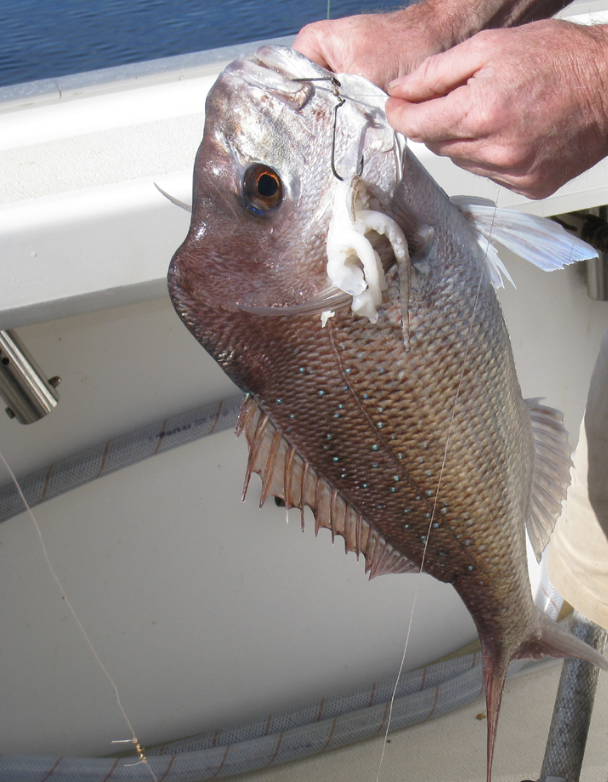
LINE SIZE
The line size really depends on the terrain you are fishing and for example, where I catch a lot of snapper off Stanwell Park, south of Sydney, the reef is not as rugged or covered with sharp coral like the grounds off Coffs Harbour. Off Stanwell Park I only ever use 6kg line and rarely ever get busted up. When I first started to fish Coffs Harbour with 6kg line I lost a lot of big snapper either cutting me off on the sharp reef or running the line through the kelp beds. I switched over to the tough Andy, 10kg line straight away and managed to control the bigger snapper much better. There was always plenty of huge, humpy headed reds landed up there I can tell you. My biggest ever knobby snapper came from the grounds off Coffs they call the Patches, weighing 11.5kgs (25lbs)!
THE BITE AND FIGHT
Anyone who has caught a big snapper will tell you the bite is very fast and aggressive and that
first run is almost unstoppable. Many an angler who has tried to stop a big snapper on its first run will talk about the one that snapped the line and got away! They need to be handled carefully and usually to hook a big one in the first place it will be on a light to medium tackle anyway. Stopping that power house, first run will either bust the line or could pull or straighten out the hooks. Playing out a big snapper carefully is real good fun and the key to success.
A SNAPPER FEED
If you’re planning on keeping some snapper for the table always bleed the fish in a fish tub as soon as it’s caught by cutting right through the gill latch. After it’s been bled, rest the whole fish on ice in a cooler to ensure the flesh settles and stays nice and firm for the best fillets or cutlets you will ever eat. However which way you cook a snapper it has a very unique flavour, particularly the east coast knobby variety. Maybe its what they eat off the hard reef areas along the east coast that gives them the culinary edge over their southern or Kiwi cousins?
What I also like to do with a good size snapper around the 3 to 4 kilo mark is remove the head from the frame after filleting and take out the gills. Using a large cooking pot three quarters filled with water and a little added salt, I submerse the head and bring the water to the boil. Back the heat off and let the water simmer for a good 50 to 60 minutes until the head completely falls apart.
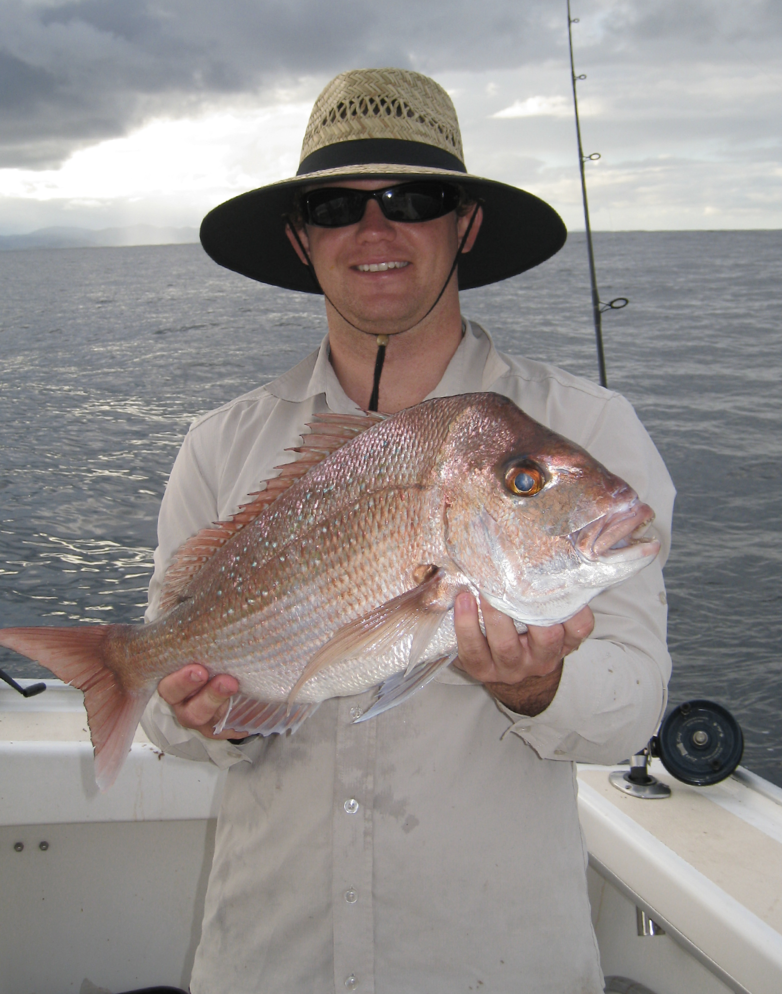
I then leave the head in the pot to cool and remove the larger pieces of skin and bone with a pair of tongs. Then I strain the liquid through a fine sieve to remove the smaller bones and any scales. This makes the most awesome fish stock and its perfect for the best seafood chowder or fish soups you have ever tried. Even in the old famous, Alice Doyle’s Cook Book, she writes; the only kind of fish to use to make seafood chowders and soups etc. are snapper heads.
THE BIG KNOBBY HEAD?
This has been a real mystery for many years as to why most of our east coast snapper develop a big bump on their head and quite often form a large fleshy looking nose and lips to go with it. These unusual looking features only ever happen to snapper along the eastern coastal seaboard of northern Victoria, NSW and southern Queensland. Although their cousins in most western parts of Victoria and all through South Australia and New Zealand are the same species, they don’t get the same unusual, prominent looking features. Why is it so?
Many of the old east coast snapper fishermen used to say that the big bump was formed by head butting the reef to break off shellfish and cunjevoi (cungie or sea aquirts). Thinking about it, I have actually caught the odd big snapper with scars and marks on the front of the knobby head (there’s one in a photo here). But were these marks from head butting the hard reef? I’m not real sure about this?
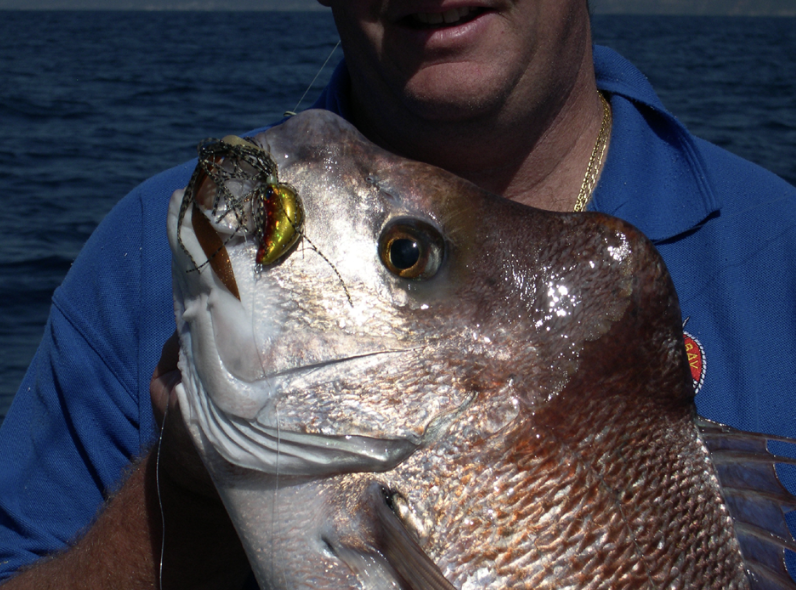
This old-school theory about the hump or bump on the head, whether true or not, is an interesting subject and one that will probably remain a mystery for many years to come? I remember back in 2001 when Dr Julian Pepperell put forth a couple of theories in his book, Fish Tales. He reckoned that the head hump could be a bone reaction from a parasite or even a bacteria the snapper might have picked up around an east coast reef at an early age? To my knowledge, Fisheries have never ever done a serious study on these east coast, knobby headed snapper to really find out what causes it? It would certainly be an interesting assignment for some young, marine biologist if ever there was a government grant handed out for such work!





